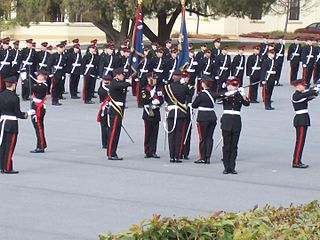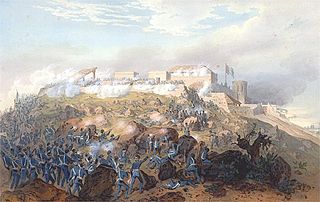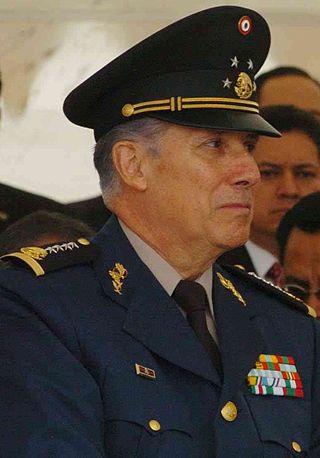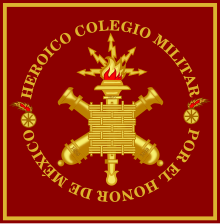
A military academy or service academy is an educational institution which prepares candidates for service in the officer corps. It normally provides education in a military environment, the exact definition depending on the country concerned.

The Battle of Chapultepec took place between a U.S. force and Mexican soldiers holding the strategically located Chapultepec Castle just outside Mexico City, fought 13 September 1847 during the Mexican–American War. The building, sitting atop a 200-foot (61 m) hill, was an important position for the defense of the city.

The San Carlos Fortress is an 18th-century fortress in the city of Perote, in the Mexican state of Veracruz. It is also known as the Fort of San Carlos, Perote Castle, the Castle of San Carlos, Perote Prison, San Carlos de Perote Fortress, and San Carlos de Perote Castle.

The Battle for Mexico City refers to the series of engagements from September 8 to September 15, 1847, in the general vicinity of Mexico City during the Mexican–American War. Included are major actions at the battles of Molino del Rey and Chapultepec, culminating with the fall of Mexico City. The U.S. Army under Winfield Scott won a major victory that ended the war.

Colegio Militar is a station on Line 2 of the Mexico City Metro system. It is located in the Miguel Hidalgo borough of Mexico City, northwest of the city centre, on Calzada México-Tacuba. In 2019 the station had an average ridership of 15,275 passengers per day.

The Niños Héroes were six Mexican military cadets who were killed in the defence of Mexico City during the Battle of Chapultepec, one of the last major battles of the Mexican–American War, on 13 September 1847. The date of the battle is now celebrated in Mexico as a civic holiday to honor the cadets' sacrifice.

Chapultepec Castle is located on top of Chapultepec Hill in Mexico City's Chapultepec park. The name Chapultepec is the Nahuatl word chapoltepēc which means "on the hill of the grasshopper". It is located at the entrance to Chapultepec park, at a height of 2,325 metres (7,628 ft) above sea level. The site of the hill was a sacred place for Aztecs, and the buildings atop it have served several purposes during its history, including serving as a military academy, imperial residence, presidential residence, observatory, and since February 1939, the National Museum of History. Chapultepec Castle, along with Iturbide Palace, also in Mexico City, are the only royal palaces in North America which were inhabited by monarchs.

The Military Academy of Agulhas Negras is the biggest among several schools of formation of combatant officers of the Brazilian Army. It originated in 1792 with the creation of the Royal Academy of Artillery, Fortification and Drawing, the first military school of the Americas, in the city of Rio de Janeiro. Today the Academy is located in the city of Resende, in the state of Rio de Janeiro.

The Mexican Army is the combined land and air branch and is the largest part of the Mexican Armed Forces; it is also known as the National Defense Army.

Gerardo Clemente R. Vega García was a Mexican general who served from 2000 to 2006 as Minister of Defense.

The Ten Tragic Days during the Mexican Revolution is the name given to the multi-day coup d'état in Mexico City by opponents of Francisco I. Madero, the democratically elected president of Mexico, between 9–19 February 1913. It instigated a second phase of the Mexican Revolution, after dictator Porfirio Díaz had been ousted and replaced in elections by Francisco I. Madero. The coup was carried out by general Victoriano Huerta and supporters of the old regime, with support from the United States.

The San Blas Battalion was a Mexican infantry unit founded in 1823 in San Blas, Nayarit. Under the name Batallón Activo Guardacostas de San Blas, it saw action on several occasions culminating in the Mexican–American War. The battalion participated in the Battle of Chapultepec, where commanded by Lt. Colonel Felipe Santiago Xicoténcatl, aided in the defense of the Military Academy in the Chapultepec Castle. Of the 300 men comprising the battalion, only a few survived the battle.

The Civil Guard was the main preventive police force of Peru until its dissolution in 1988. As a national gendarmerie force, it was responsible for civil policing under the authority of the Ministry of the Interior, while investigative work was carried out by the Peruvian Investigative Police. It was also supported at times by the Republican Guard. During its dissolution process, it became known as the General Police until its formal integration into the National Police of Peru in 1991. The corps is colloquially known as the benemérita (reputable).

The Heroica Escuela Naval Militar is the officer training academy of the Mexican Navy.

The National Military College is the institution in charge of the undergraduate education of officers of the Argentine Army. It is located at El Palomar, Buenos Aires.
Gregorio Ruiz was a Mexican general who participated in the Mexican Revolution. He was born in Perote, Veracruz and he died in Mexico City in 1913. He studied at the Heroico Colegio Militar, and by 1864 was a lieutenant of auxiliaries in the Mexican Army. He fought against the French Intervention in Mexico and ensuing empire of Maximilian I of Mexico (1862–1867). He participated in the pacification campaigns of Puebla and Oaxaca in 1876, and in Tepic and Sinaloa in 1877 and 1888.

Francisco Luis Urquizo Benavides was a Mexican soldier, writer and historian who fought in the Mexican Revolution, rose to the rank of major general, and served as Secretary of National Defense. He was also one of the most significant authors in the genre of historical fiction known as the "novela revolucionaria," a term used to describe works set during the Mexican Revolution. Tropa vieja, which is considered his major narrative work, earned him the sobriquet "novelist of the soldier."

The 16 September military parade in honour of the anniversary of Mexican Independence is an annual tradition dating back to the late 19th century and the beginning of the professionalisation of the Mexican Armed Forces in the 20th century. Held yearly in the Zócalo in Mexico City, this parade, the largest of the various parades held simultaneously nationwide on September 16, Mexican Independence Day, is presided by the President of Mexico in the fulfillment of his duty as the Supreme Commander of the Armed Forces. It is also attended by members of the Cabinet of Mexico, the Congress of the Union, civil service employees, the Secretaries of National Defense and Navy, members of the Mexican Armed Forces, uniformed service veterans, the state diplomatic corps, delegations representing the religious sector, indigenous peoples, sports and the private sector, and the general public. Seen on TV and the Internet and heard on radio, this is one of the biggest events of the year. Taking part in this are members of the Mexican Armed Forces and the National Guard.

The "Mariscal Domingo Nieto" Cavalry Regiment Escort is the Household Cavalry and Dragoon Guards regiment of the Peruvian Army since 1904, having been inactive from 1987 to 2012.

The modern Mexican Legion of Honor is an order of merit awarded to soldiers, veterans, and others who have made outstanding contributions to the national defense, security, or sovereignty of Mexico. An earlier, post-revolutionary version was organized as a military reserve force.























